Xiaoshuang Zhou
Multi-objective optimization and explanation for stroke risk assessment in Shanxi province
Jul 31, 2021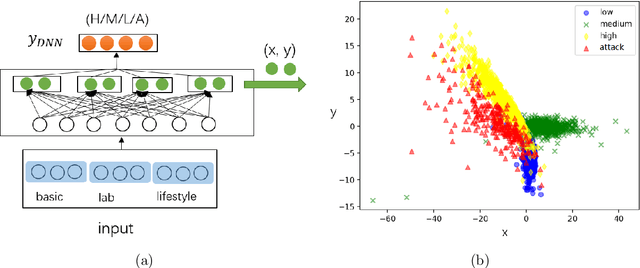
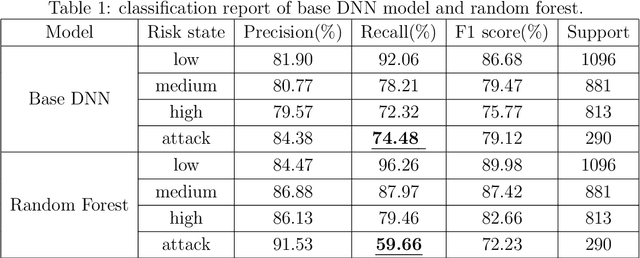
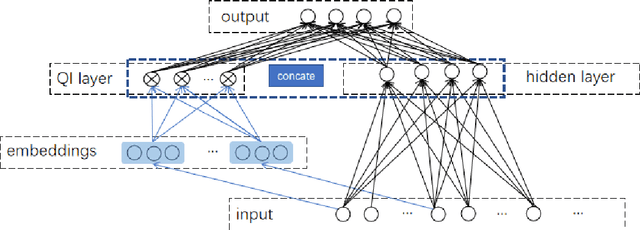
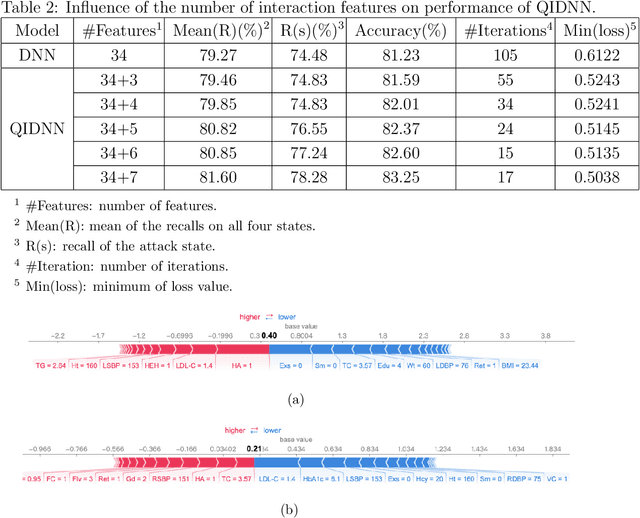
Abstract:Stroke is the top leading causes of death in China (Zhou et al. The Lancet 2019). A dataset from Shanxi Province is used to identify the risk of each patient's at four states low/medium/high/attack and provide the state transition tendency through a SHAP DeepExplainer. To improve the accuracy on an imbalance sample set, the Quadratic Interactive Deep Neural Network (QIDNN) model is first proposed by flexible selecting and appending of quadratic interactive features. The experimental results showed that the QIDNN model with 7 interactive features achieve the state-of-art accuracy $83.25\%$. Blood pressure, physical inactivity, smoking, weight and total cholesterol are the top five important features. Then, for the sake of high recall on the most urgent state, attack state, the stroke occurrence prediction is taken as an auxiliary objective to benefit from multi-objective optimization. The prediction accuracy was promoted, meanwhile the recall of the attack state was improved by $24.9\%$ (to $84.83\%$) compared to QIDNN (from $67.93\%$) with same features. The prediction model and analysis tool in this paper not only gave the theoretical optimized prediction method, but also provided the attribution explanation of risk states and transition direction of each patient, which provided a favorable tool for doctors to analyze and diagnose the disease.
Analysis and classification of main risk factors causing stroke in Shanxi Province
May 29, 2021

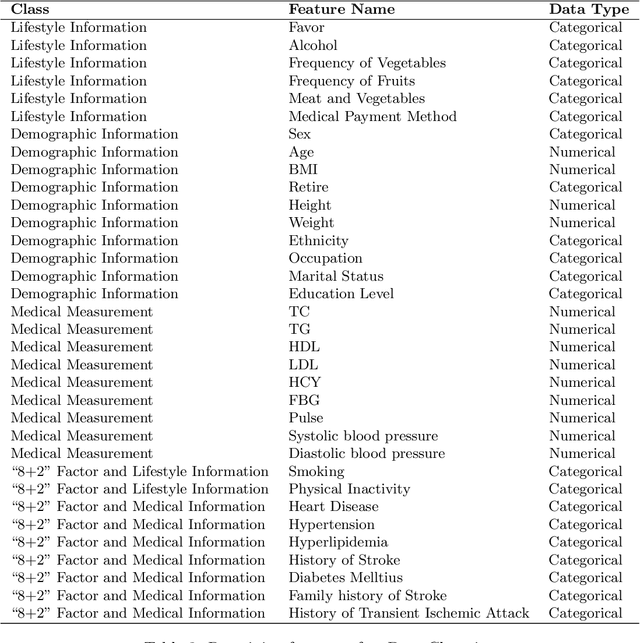

Abstract:In China, stroke is the first leading cause of death in recent years. It is a major cause of long-term physical and cognitive impairment, which bring great pressure on the National Public Health System. Evaluation of the risk of getting stroke is important for the prevention and treatment of stroke in China. A data set with 2000 hospitalized stroke patients in 2018 and 27583 residents during the year 2017 to 2020 is analyzed in this study. Due to data incompleteness, inconsistency, and non-structured formats, missing values in the raw data are filled with -1 as an abnormal class. With the cleaned features, three models on risk levels of getting stroke are built by using machine learning methods. The importance of "8+2" factors from China National Stroke Prevention Project (CSPP) is evaluated via decision tree and random forest models. Except for "8+2" factors the importance of features and SHAP1 values for lifestyle information, demographic information, and medical measurement are evaluated and ranked via a random forest model. Furthermore, a logistic regression model is applied to evaluate the probability of getting stroke for different risk levels. Based on the census data in both communities and hospitals from Shanxi Province, we investigate different risk factors of getting stroke and their ranking with interpretable machine learning models. The results show that Hypertension (Systolic blood pressure, Diastolic blood pressure), Physical Inactivity (Lack of sports), and Overweight (BMI) are ranked as the top three high-risk factors of getting stroke in Shanxi province. The probability of getting stroke for a person can also be predicted via our machine learning model.
MSA-MIL: A deep residual multiple instance learning model based on multi-scale annotation for classification and visualization of glomerular spikes
Jul 02, 2020

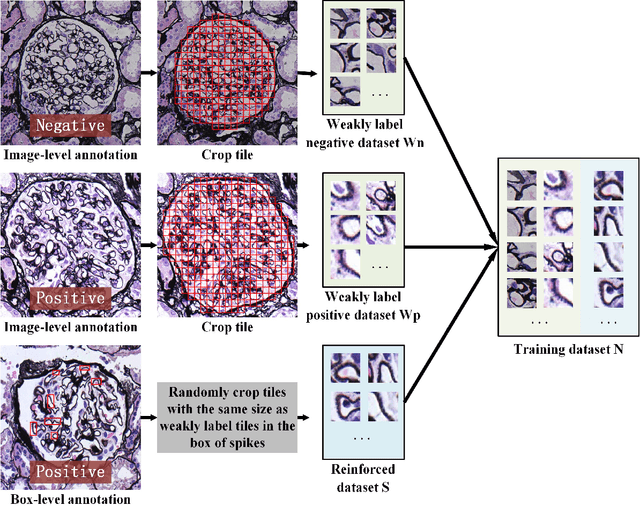
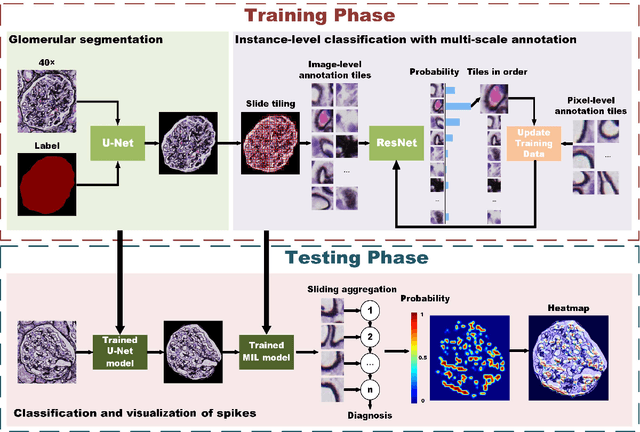
Abstract:Membranous nephropathy (MN) is a frequent type of adult nephrotic syndrome, which has a high clinical incidence and can cause various complications. In the biopsy microscope slide of membranous nephropathy, spikelike projections on the glomerular basement membrane is a prominent feature of the MN. However, due to the whole biopsy slide contains large number of glomeruli, and each glomerulus includes many spike lesions, the pathological feature of the spikes is not obvious. It thus is time-consuming for doctors to diagnose glomerulus one by one and is difficult for pathologists with less experience to diagnose. In this paper, we establish a visualized classification model based on the multi-scale annotation multi-instance learning (MSA-MIL) to achieve glomerular classification and spikes visualization. The MSA-MIL model mainly involves three parts. Firstly, U-Net is used to extract the region of the glomeruli to ensure that the features learned by the succeeding algorithm are focused inside the glomeruli itself. Secondly, we use MIL to train an instance-level classifier combined with MSA method to enhance the learning ability of the network by adding a location-level labeled reinforced dataset, thereby obtaining an example-level feature representation with rich semantics. Lastly, the predicted scores of each tile in the image are summarized to obtain glomerular classification and visualization of the classification results of the spikes via the usage of sliding window method. The experimental results confirm that the proposed MSA-MIL model can effectively and accurately classify normal glomeruli and spiked glomerulus and visualize the position of spikes in the glomerulus. Therefore, the proposed model can provide a good foundation for assisting the clinical doctors to diagnose the glomerular membranous nephropathy.
 Add to Chrome
Add to Chrome Add to Firefox
Add to Firefox Add to Edge
Add to Edge